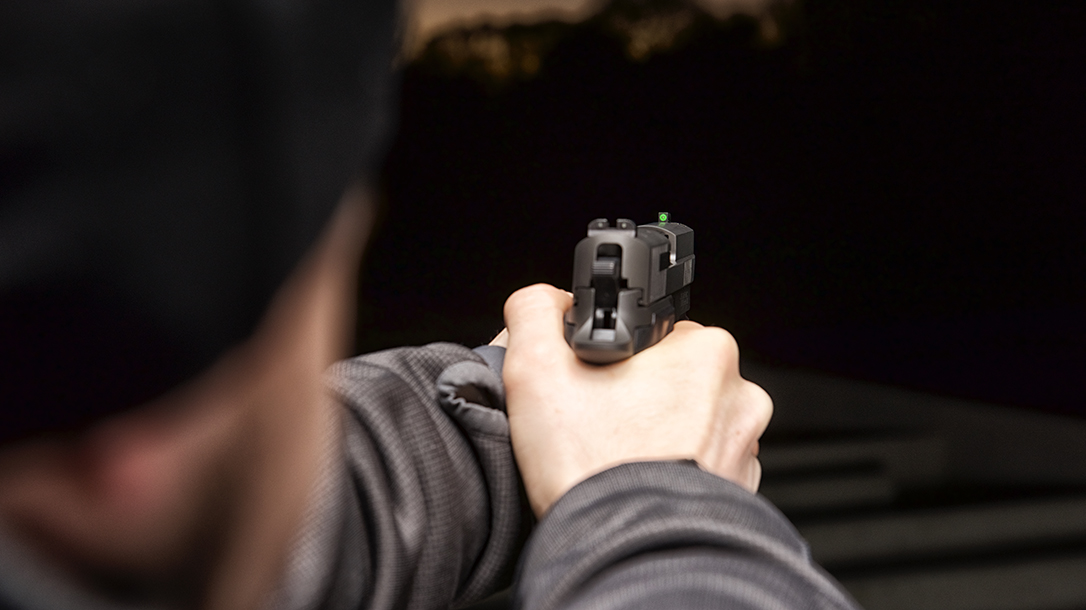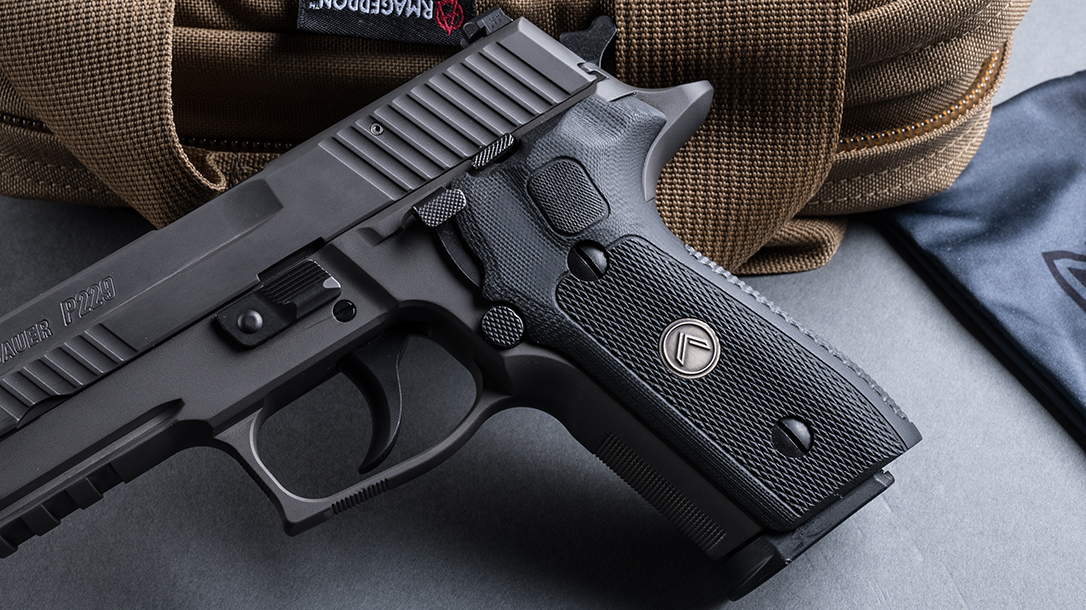For the last several years, SIG Sauer has been one of the most progressive, and aggressive, forces in the firearm market. From the introduction of the MCX carbine to the P320 pistol, SIG Sauer’s accomplishments have overshadowed the rest of the industry. The MCX was selected as the new rifle for London’s Metropolitan Police Counter Terrorist Command while the P320 was selected as the new service pistol by the U.S. Army. When I visited SIG last year, there was a lot of excitement in the air. During my visit, I was draw to the SIG P229 Legion pistol.
I have always been drawn to the P229 because of its compact size and ergonomics. A follow-up to the SIG P228, the P229 is a mid-sized pistol with a double-stack magazine and traditional double-action/single-action (DA/SA) fire controls. Available in 9mm, .357 SIG and .40 S&W, the P229 is a workhorse, serving as the issued pistol for the U.S. Secret Service, Federal Air Marshall Service and ICE for many years. If the standard P229 is good, then the Legion version is spectacular.
Advertisement — Continue Reading Below
Join the Legion
For those unfamiliar with the Legion program, it was introduced in 2015 with a series of branded products, accessories and fanfare. The Legion is both a line of enhanced pistols and a customer loyalty program. Owning a Legion allows you to access Legion-branded accessories. It is basically SIG Sauer’s fraternity for professional users.
I received a SIG P229 Legion for testing and was very impressed. Like others in the series, the P229 Legion has a proprietary gray PVD finish and features custom G10 grip panels with the Legion chevron medallions.
Starting at the top, I immediately took note of the SIG Sauer X-Ray high-visibility sights. The front sight has a tritium insert surrounded by a luminescent green capsule. The rear sight has two traditional tritium inserts that offer a distinct contrast to the front sight. The rear sight also features a forward cocking ledge for single-handed manipulations. Another unique touch is the Legion logo engraved on the top of the slide, just forward of the rear sight.
Advertisement — Continue Reading Below
The alloy frame of the SIG P229 Legion features several enhancements that are both functional and attractive, including an extended Elite beavertail that, combined with the undercut X-Five frame, allows for a higher purchase on the pistol. The frontstrap has received a more aggressive checkering that has also been applied on the bottom and front of the triggerguard.
Other SIG P229 Legion Features
Mechanically, the P229 Legion features an enhanced, polished action with an adjustable, short-reset trigger that has been augmented by Grayguns Inc. As mentioned, this is a DA/SA pistol. Its controls include the takedown lever, decocking lever, slide release and magazine catch.
Field-stripping the P229 is both safe and easy. After removing the magazine, the user manually locks the slide to the rear. With the slide locked to the rear, the user rotates the takedown lever downward. The slide stop is then released, and the slide comes off the front of the frame. One warning: The user should maintain control of the slide to prevent it from launching across the room.
Advertisement — Continue Reading Below
The SIG P229 and P228 have always felt good in my hands. The contour of the backstrap helps negate the size needed for a double-stack pistol. The DA trigger pull on my test pistol was long, but smooth, with slight stacking at the end. I was unable to measure the DA pull with my gauge, but the SA pull broke cleanly at 4.5 pounds with minimum overtravel thanks to the enhanced trigger controls.
Fresh Threads
When ordering the SIG P229 Legion, I also requested a factory-threaded barrel that would allow me to also shoot it with SIG’s excellent SRD9 suppressor. The SRD9 is a very refined suppressor that is 7.2 inches in length, 1.38 inches in diameter and weighs 9 ounces. The tube is manufactured from Grade 9 titanium while the baffles are constructed from 17-4PH stainless steel. The SRD9 is also user serviceable in that the baffles can be removed for cleaning and, if need be, replacement.
In keeping with SIG’s commitment to its customers, the SRD9 comes with pistons for both 1/2×28 and left-hand 13.5x1mm threading, as well as a fixed-barrel spacer. This is a very nice addition that I would like to see other companies consider. According to the technical data, the SRD9 meters in the 128-decibel range with subsonic ammunition.
Advertisement — Continue Reading Below
When range day came, I was fortunate to have a wide variety of 9mm ammunition on hand. I tested the SIG P229 Legion with a total of eight different rounds that ranged from Super Vel’s hot 90-grain +P JHPs to Gorilla’s Silverback 135-grain solid-copper hollow points (SCHPs). In between testing premium loads, I also ran a couple hundred rounds of Aguila’s115-grain FMJs and Super Vel’s 147-grain Hush Puppy subsonic load. Regardless of bullet weight or velocity, the P229 ate it all without missing a beat. All of the subsonic loads were 100-percent reliable with the SRD9 suppressor installed. My groups averaged under 2 inches when the 229 Legion was shot from a benchrest at 25 yards.
Drilling Down
It has been a long time since I have run a DA/SA pistol, and I found the long DA trigger to be a challenge. After working out the kinks and getting the feel for the P229, I ran a couple of repetitions of Ken Hackathorn’s “10-10-10” drill, where you fire 10 shots at an NRA bullseye target at 10 yards in 10 seconds. I didn’t have a holster for the P229, so I started from a compressed ready position.
Advertisement — Continue Reading Below
On my first run, I pulled the first two rounds into the 8 ring and put three shots in the 9 ring. I scored a 93 in 7.41 seconds. My second run was shot in 9.25 seconds with a score of 96. However, I still pulled the first round into the 8 ring and had two rounds in the 9 ring. Still, I was pretty pleased at how the P229 Legion handled. I also recognized I needed to work more on that first DA shot.
In order to improve my performance, I ran several double-action-only drills from 7 yards. Using a rapid-fire NRA bullseye target placed 7 yards downrange, I started from a high-ready position and fired with a par time of 1.5 seconds. The third time I ran the drill, I scored a 96 with one round in the 8 ring and two rounds in the 9 ring. Before the next outing, I spent some time on dry-fire drills at home and found my performance improved. If I were going to carry the P229 for personal defense, I would regularly work on my DA pull to improve my grip, trigger control and sight picture. I did notice that the front sight on the 229 Legion was significantly shorter than I am accustomed to running. This took some getting used to.
Ammo Performance
From a performance standpoint, the SRD9 was a true joy to shoot on the SIG P229 Legion. I tested five subsonic loads that ranged from 123 to 147 grains.
Advertisement — Continue Reading Below
The 123-grain American Eagle Suppressor load from Federal averaged 1,031 fps and was slightly louder than the heavier 147-grain subsonic loads. However, this is an economical load, and I’m glad Federal is offering suppressor-specific loads in its American Eagle line.
For personal defense, Gorilla’s 135-grain Silverback SCHPs averaged 886 fps. It was extremely quiet and has proven to penetrate and expand reliably. SIG’s 147-grain V-Crown load is not specifically designed to be a subsonic load. It averaged 1,020 fps and was slightly louder than the Gorilla load but still performed well with the SRD9. Both the 147-grain Speer Lawman and Super Vel Hush Puppy FMJs averaged 980 and 919 fps, respectively. This is really the sweet spot, and both proved to be ideal.
Have It Your Way
The Legion is only one of seven P229 models currently available, including the P229 RX, which is set up with a SIG ROMEO1 reflex sight, and the M11-A1, a commercial copy of the M11 pistol issued to specific U.S. military units. The M11 features a black mil-spec finish with phosphated internal parts and controls. The M11 passes the military’s 240-hour salt spray corrosion test while the barrel life exceeds 20,000 rounds. In addition, the M11 is also equipped with a Short-Reset Trigger and a UID barcode on the left side of the frame.
Advertisement — Continue Reading Below
The Legion series also includes the full-sized P226 and P220. Like the P229, the P226 Legion is available in 9mm, .357 SIG and .40 S&W. For those in need of a larger caliber, the SIG P220 is a full-sized single-stack model that is offered in .45 ACP and 10mm. The Legion P226 and P220 share the same features and enhancements as our test P229.
SIG has always been respected for its designs and quality. The Legion series takes this to a new level, with the P229 Legion taking the lead. This pistol, when combined with the SRD9 suppressor, ranks high on the coolness scale. For those who already own a SIG pistol, you can order a threaded barrel and other accessories directly from SIG’s Pro Shop. The Pro Shop also offers a full line of suppressor accessories and parts, including pistons and thread protectors. In the end, SIG really is a one-stop shop for everything shooters need.
For more information, visit SigSauer.com.
Advertisement — Continue Reading Below
SIG P229 Legion Specs
- Caliber: 9mm
- Barrel: 3.9 inches
- OA Length: 7.4 inches
- Weight: 34.4 ounces (empty)
- Grips: G10
- Sights: X-Ray day/night
- Action: DA/SA
- Finish: PVD
- Capacity: 15+1
- MSRP: $1,413
This story is from the spring 2018 issue of Ballistic Magazine. Grab your copy at OutdoorGroupStore.com. Or get your digital only subscription on Amazon!





























